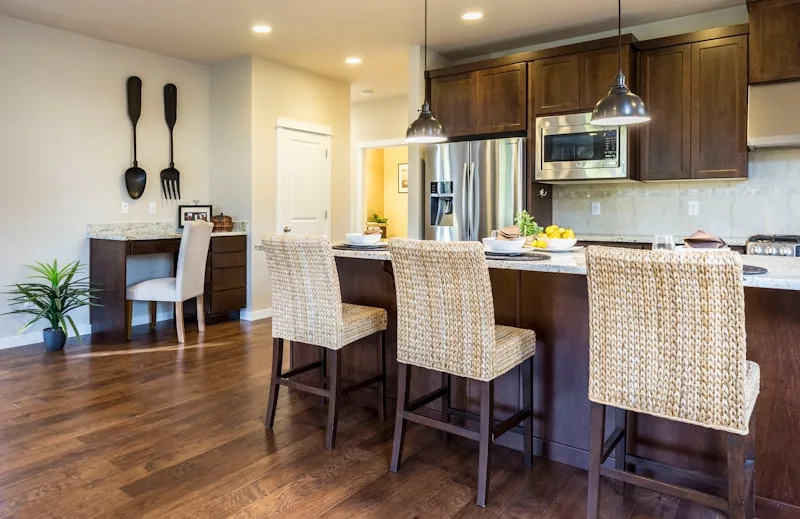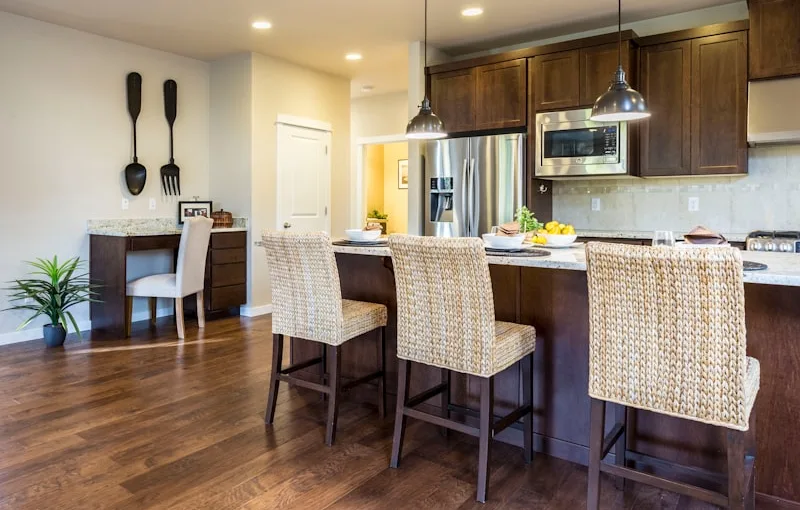First off, you’ll want to start with a good cleaning. Grab some warm, soapy water and a sponge to wipe down those cabinets. This step is crucial because any grease or grime can mess with your stain’s ability to adhere. Think of it like prepping a canvas before painting; you wouldn’t want any smudges ruining your masterpiece!
Next, consider using a liquid deglosser. This magical potion works wonders by breaking down the glossy finish on your cabinets without the need for sanding. Just apply it with a cloth, and watch as it preps your surface for staining. It’s like giving your cabinets a mini spa day!
Now, onto the fun part—staining! Choose a stain that complements your kitchen’s vibe. Whether you’re going for a rich walnut or a light oak, the right color can make all the difference. Use a foam brush or a lint-free cloth to apply the stain, working in small sections. Remember, less is more! You can always add more layers if you want a deeper color.
After you’ve stained your cabinets, let them dry completely. This is where patience pays off. Once dry, consider sealing your work with a clear topcoat to protect that beautiful finish. It’s like putting a cherry on top of your sundae!
Revamp Your Kitchen: The Ultimate Guide to Staining Cabinets Without Sanding
First off, you’ll want to gather your supplies. Think of this as your treasure hunt! You’ll need a good quality wood stain, a clean cloth, and a trusty foam brush. These tools are your magic wands, ready to work wonders. Now, before you start, give those cabinets a good wipe down. You wouldn’t want dust and grime crashing your party!
Next, it’s all about the application. Dip your foam brush into the stain and apply it in long, even strokes. Picture yourself painting a sunset—smooth and flowing. The beauty of staining is that you can control the depth of color. Want a light wash? Go easy on the stain. Prefer a bold look? Layer it on! Just remember, patience is key. Let each coat dry before adding another, like waiting for the perfect moment to take a bite of your favorite dessert.
Now, here’s a pro tip: if you’re feeling adventurous, try mixing stains to create a custom shade. It’s like being a chef in your kitchen, experimenting with flavors until you find the perfect recipe. And don’t forget to seal the deal with a protective topcoat. This will keep your cabinets looking fresh and fabulous for years to come.
So, are you ready to roll up your sleeves and give your kitchen a stunning makeover? With a little creativity and the right approach, you can achieve a beautiful transformation that will leave everyone in awe!
No Sanding, No Problem: Transform Your Kitchen Cabinets with These Easy Staining Tips
First off, let’s talk about prep. You don’t need to sand; just clean your cabinets thoroughly. Think of it as giving them a refreshing shower. Use a mild detergent and a soft cloth to wipe away grease and grime. This step is crucial because a clean surface allows the stain to adhere better, ensuring a beautiful finish.
Next, choose your stain wisely. There are tons of options out there, from rich mahogany to trendy gray. It’s like picking the perfect outfit for a night out—go for something that reflects your style! Once you’ve made your choice, grab a foam brush or a lint-free cloth. Apply the stain in even strokes, working with the grain of the wood. It’s almost like painting a masterpiece; take your time and enjoy the process!
Now, here’s a pro tip: if you want a deeper color, don’t hesitate to apply a second coat. Just make sure to let the first coat dry completely. Think of it as layering your favorite perfume—sometimes, a little extra goes a long way!
Stain Your Kitchen Cabinets Like a Pro: A No-Sanding Approach for Stunning Results
Imagine transforming your kitchen into a stunning space with just a little bit of stain and some elbow grease. First things first, you’ll want to clean those cabinets thoroughly. Think of it as giving them a refreshing shower—removing grease and grime will help the stain adhere better. Once they’re squeaky clean, grab a high-quality stain that matches your vision. Whether you’re going for a rich walnut or a sleek gray, the right color can breathe new life into your kitchen.
Now, here’s the magic trick: instead of sanding, use a deglosser. This nifty product works like a charm, prepping your cabinets for staining without the hassle of sanding. Just apply it with a cloth, and watch as it removes the glossy finish, allowing the stain to penetrate beautifully.
When it’s time to apply the stain, think of it like painting a masterpiece. Use a brush or a foam applicator to spread the stain evenly, working in small sections. Don’t rush! Take your time to ensure every nook and cranny gets that luscious color. And here’s a pro tip: wipe off any excess stain after a few minutes to achieve that perfect finish.
Once you’ve stained all your cabinets, let them dry completely. It’s like waiting for a cake to bake—patience is key! The result? A kitchen that looks professionally done, all without the dust and hassle of sanding. So, are you ready to give your kitchen a fabulous facelift?
From Drab to Fab: How to Stain Kitchen Cabinets Without the Hassle of Sanding
First off, let’s talk about the magic of liquid deglosser. This little wonder is like a fairy godmother for your cabinets. Instead of spending hours sanding, you simply wipe it on with a cloth. It removes the glossy finish, allowing your new stain to adhere beautifully. Think of it as giving your cabinets a refreshing facial—no harsh scrubs required!
Next, choose your stain wisely. Whether you’re into rich mahogany or a light oak, the right color can completely change the vibe of your kitchen. It’s like picking the perfect outfit for a big night out; you want something that makes you feel fabulous! Once you’ve got your stain, grab a foam brush and start applying. The key here is to work in sections, so you don’t end up with uneven patches.
And here’s a pro tip: always wipe off the excess stain after a few minutes. This step is crucial because it helps you achieve that gorgeous, even finish. It’s like polishing a diamond—too much roughness, and you lose the sparkle!
Quick and Easy Cabinet Makeover: Staining Techniques That Skip the Sandpaper
First off, let’s talk about the magic of liquid deglosser. Think of it as a superhero for your cabinets. This nifty product preps your surfaces by removing the glossy finish, allowing the stain to adhere beautifully. Just apply it with a cloth, and voilà! You’re ready to stain without the back-breaking work of sanding.
Next up, consider using gel stains. These are like the icing on the cake for your cabinets. They’re thicker than traditional stains, which means they cling to the surface without running or dripping. Plus, they come in a variety of colors, so you can easily find the perfect shade to match your style. Just grab a brush, apply the gel, and watch your cabinets transform right before your eyes!
And let’s not forget about the power of a good topcoat. After staining, a clear polyurethane finish can protect your cabinets from scratches and spills. It’s like putting a shield on your newly stained cabinets, ensuring they stay gorgeous for years to come.
Unlock the Secret to Beautifully Stained Cabinets Without Sanding: A Step-by-Step Guide

First things first, gather your supplies. You’ll need a good quality wood stain, a clean cloth, a foam brush, and a wood conditioner. Think of the wood conditioner as a warm-up for your cabinets—it preps the surface and helps the stain glide on smoothly. Apply the conditioner with a foam brush, making sure to cover every nook and cranny. It’s like giving your cabinets a spa day!
Once the conditioner has dried, it’s time for the fun part: staining! Choose a stain that complements your home’s style. Using a clean cloth, apply the stain in the direction of the wood grain. Picture it like painting a masterpiece; each stroke adds depth and character. Don’t be afraid to experiment with different shades—this is your chance to let your creativity shine!
After applying the stain, let it sit for a few minutes before wiping off the excess. This step is crucial; it’s where the magic happens! The longer you let it sit, the richer the color will be. Think of it as letting a fine wine breathe.
Frequently Asked Questions
How Long Does No-Sand Cabinet Staining Take to Dry?
The drying time for no-sand cabinet staining typically ranges from 1 to 4 hours, depending on factors such as humidity, temperature, and the specific product used. For optimal results, it’s advisable to allow at least 24 hours before applying a topcoat or additional layers.
What Materials Do I Need for No-Sand Cabinet Staining?
To stain cabinets without sandpaper, you will need a degreaser or cleaner to prepare the surface, a high-quality stain suitable for no-sand applications, a foam brush or lint-free cloth for application, and a topcoat for protection. Additionally, ensure you have gloves and drop cloths to protect your workspace.
What Techniques Ensure a Smooth Finish When Staining?
To achieve a smooth finish when staining, start by preparing the surface through sanding to remove imperfections. Use a high-quality brush or cloth for application, working in the direction of the grain. Apply thin, even coats and allow adequate drying time between applications. Finally, consider using a wood conditioner before staining to promote even absorption and prevent blotchiness.
Can I Stain Kitchen Cabinets Without Sanding?
Yes, you can stain kitchen cabinets without sanding by using a gel stain or a stain designed for use on previously finished surfaces. Clean the cabinets thoroughly to remove grease and dirt, then apply the stain with a brush or cloth. This method allows you to refresh the look of your cabinets without the labor-intensive process of sanding.
How Do I Prepare Cabinets for Staining Without Sanding?
To prepare cabinets for staining without sanding, start by cleaning the surfaces thoroughly with a degreaser to remove any dirt or grease. Next, apply a liquid deglosser using a cloth to dull the existing finish, which helps the stain adhere better. After deglossing, wipe down the cabinets with a clean, damp cloth to remove any residue. Finally, allow the cabinets to dry completely before applying the stain for a smooth and even finish.
